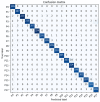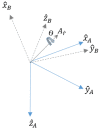Buildings' Biaxial Tilt Assessment Using Inertial Wireless Sensors and a Parallel Training Model
- PMID: 37300079
- PMCID: PMC10256024
- DOI: 10.3390/s23115352
Buildings' Biaxial Tilt Assessment Using Inertial Wireless Sensors and a Parallel Training Model
Abstract
Applications of MEMS-based sensing technology are beneficial and versatile. If these electronic sensors integrate efficient processing methods, and if supervisory control and data acquisition (SCADA) software is also required, then mass networked real-time monitoring will be limited by cost, revealing a research gap related to the specific processing of signals. Static and dynamic accelerations are very noisy, and small variations of correctly processed static accelerations can be used as measurements and patterns of the biaxial inclination of many structures. This paper presents a biaxial tilt assessment for buildings based on a parallel training model and real-time measurements using inertial sensors, Wi-Fi Xbee, and Internet connectivity. The specific structural inclinations of the four exterior walls and their severity of rectangular buildings in urban areas with differential soil settlements can be supervised simultaneously in a control center. Two algorithms, combined with a new procedure using successive numeric repetitions designed especially for this work, process the gravitational acceleration signals, improving the final result remarkably. Subsequently, the inclination patterns based on biaxial angles are generated computationally, considering differential settlements and seismic events. The two neural models recognize 18 inclination patterns and their severity using an approach in cascade with a parallel training model for the severity classification. Lastly, the algorithms are integrated into monitoring software with 0.1° resolution, and their performance is verified on a small-scale physical model for laboratory tests. The classifiers had a precision, recall, F1-score, and accuracy greater than 95%.
Keywords: biaxial tilt angle; building applications; inclination severity; real-time measurement; signal processing; structural health monitoring; time-series algorithms.
Conflict of interest statement
The authors declare no conflict of interest.
Figures



















Similar articles
-
Height compensation using ground inclination estimation in inertial sensor-based pedestrian navigation.Sensors (Basel). 2011;11(8):8045-59. doi: 10.3390/s110808045. Epub 2011 Aug 15. Sensors (Basel). 2011. PMID: 22164061 Free PMC article.
-
Design and Implementation of a Wireless Sensor Network for Seismic Monitoring of Buildings.Sensors (Basel). 2021 Jun 4;21(11):3875. doi: 10.3390/s21113875. Sensors (Basel). 2021. PMID: 34199758 Free PMC article.
-
Human activity monitoring system based on wearable sEMG and accelerometer wireless sensor nodes.Biomed Eng Online. 2018 Nov 20;17(Suppl 1):132. doi: 10.1186/s12938-018-0567-4. Biomed Eng Online. 2018. PMID: 30458783 Free PMC article.
-
Random Error Reduction Algorithms for MEMS Inertial Sensor Accuracy Improvement-A Review.Micromachines (Basel). 2020 Nov 21;11(11):1021. doi: 10.3390/mi11111021. Micromachines (Basel). 2020. PMID: 33233457 Free PMC article. Review.
-
Load and performance monitoring in wheelchair court sports: A narrative review of the use of technology and practical recommendations.Eur J Sport Sci. 2023 Feb;23(2):189-200. doi: 10.1080/17461391.2021.2025267. Epub 2022 Feb 13. Eur J Sport Sci. 2023. PMID: 34974822 Review.
References
-
- Mayoral J.M., Tepalcapa S., Roman-de la Sancha A., El Mohtar C.S., Rivas R. Ground Subsidence and Its Implication on Building Seismic Performance. Soil Dyn. Earthq. Eng. 2019;126:105766. doi: 10.1016/j.soildyn.2019.105766. - DOI
-
- Ozer E., Feng M.Q. Start-Up Creation. Woodhead Publishing; Sawston, UK: 2020. Structural Health Monitoring; pp. 345–367. - DOI
-
- Turrisi S., Cigada A., Zappa E. A Cointegration-Based Approach for Automatic Anomalies Detection in Large-Scale Structures. Mech. Syst. Signal Process. 2022;166:108483. doi: 10.1016/j.ymssp.2021.108483. - DOI
-
- Helmer-Smith H., Vlachopoulos N., Dagenais M.A., Forbes B. Comparison of Multiple Monitoring Techniques for the Testing of a Scale Model Timber Warren Truss. Facets. 2021;6:1510–1533. doi: 10.1139/facets-2021-0001. - DOI
MeSH terms
Grants and funding
LinkOut - more resources
Full Text Sources
Miscellaneous

